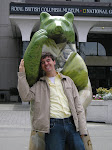In five weeks, I plan to submit my completed string quartet for initial review. My quartet listening has been very rewarding, but one can assimilate styles only so quickly.
Today I listened to Davies' Little Quartet No. 1 again, this time without the score, and couldn't hear the same cleverness and melodic interplay I did last time.
I also listened to two slow Borodin movements: No. 1 Mvt. 2, and No. 2 Mvt. 3. My attention waned during the first track, but his Notturno from Quartet No. 2 is really lovely to listen to.
Although I've tried out many different compositional tools, methods, and aesthetic goals in the past four years, my primary outlet remains a singable melody.
This is no surprise considering my musical background: Catholic church hymns (no vocal harmonies) and 90's country music, followed circa 1997 by Billy Joel, Ben Folds, and 80's/90's musical theater: Les Miz, Phantom of the Opera, Songs for a New World.
While I sang in numerous choirs up through undergrad, and played trumpet/baritone horn through high school, the active consumption of classical music was largely absent from my musical diet.
The first live classical music I remember hearing was the Canadian Brass and/or South Dakota Symphony Orchestra in Sioux Falls, probably sometime around 1997. My first opera experience was Fargo-Moorhead's Madama Butterfly in 2004 (five years ago, at age 21!).
I've been a composition major since 2001, and a serious composer since 2004.
I'm not exactly sure what I'm getting at here, other than to explain (or excuse?) my periodic struggles with "contemporary classical" composition, using models from Debussy to today. I am alternatingly fascinated, challenged, confused and bored by the prospect of "writing like them."
It seems to me that, even more so than the "death" of functional tonality, the Twentieth Century also accomplished a profound dissolution of melody as the primary structural force in a composition. (Ooh, that's a nice sentence! I'll have to remember that.)
Gesture, color, rhythm, timbre, register, text, process, technology... Virtually every post-1900 work I've heard seems to function as an exploration of one or more of these facets. (There are exceptions - Barber, some Copland - often derided as behind the times.) And yet, even the majority of classical musicians are never explicitly trained to listen for these alternate aspects as delineators of form.
Okay, so that's a long digression that I needed to get out. If you haven't guessed already, I'm hesitantly beginning the middle section for my beautifully melodic, consonant, lyrical second movement, and I'm in no place artistically to say anything worthwhile.
Perhaps a series of distinct timbral environments presented in Rondo form? Eh...
Subscribe to:
Post Comments (Atom)


I'm glad I'm not the only one, Kyle. My experiments with non-melodically focused music never turn out all that well. Maybe some day someone will look back at you and I and wonder why we were so behind the times, hah.
ReplyDelete